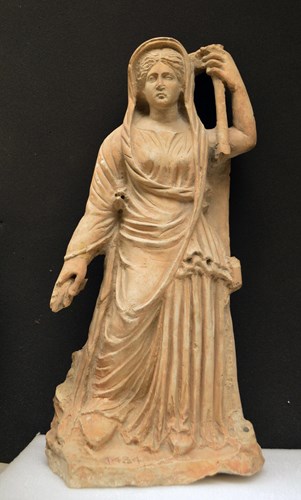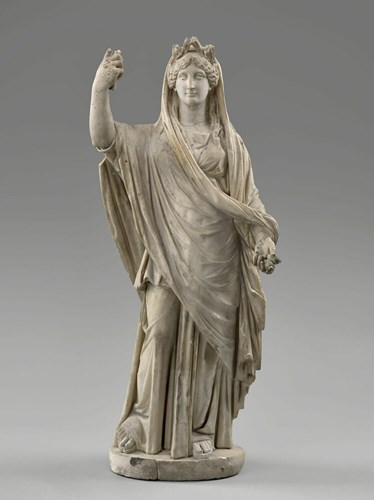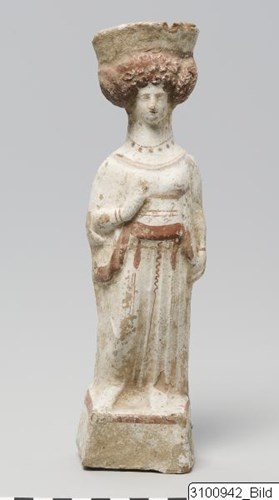Demeter is the goddess of agriculture. She is the daughter of Kronos and Rhea and sister (and the occasional consort) of Zeus. Unlike most Olympian gods, Homer rarely mentions her in his two great epic poems (the Iliad and the Odyssey). Still, she is the star and protagonist of her very own poem, the so-called Homeric Hymn to Demeter. It is an exciting work of literature that preserves the legend of Persephone, daughter of Demeter by Zeus, who is raped by Hades, the lord of the Underworld.
Demeter, primarily a mother, embarks on an epic journey to find her daughter. Along the way, she associates with the royal families of Eleusis and teaches them the secret rites of the Eleusinian Mysteries and the art of agriculture. As a grain goddess, Demeter is often identified with a grain sheaf. The legend of Persephone and the tribulations that lead to her eventual reunion with her mother must be ancient and justify a search for Demeter’s worship in the ritual associated with the primaeval grain mother. Grain was significant in Eleusis and the Mysteries. Still, Demeter was responsible for vegetation in general and all the fruits of the earth (the only exception is the bean, even though the reason for this remains obscure). During her search for Persephone, humanity faced famine due to Demeter’s refusal to allow seeds to grow, even though mortals were supposedly not yet familiar with grains. Her association with the earth and its productive capacity identifies Demeter with the Great Mother of the Gods (Cybele, also identified with Rhea).

Limestone and stucco statue of Demeter holding ears of corn and a staff, 150-200, sculpture, The British Museum © The Trustees of the British Museum
The significance of agriculture for the survival of ancient Greeks is reflected in the number of agrarian festivals held in honour of Demeter. The Athenian calendar was full of celebrations aimed at securing the goddess’ benevolence. The Haloa derived its name from the halōs (“threshing floor”). It was held in the month of Poseideon (December-January) and involved the threshing floor of Triptolemus in Eleusis. In the early spring, Athenians and Eleusinians held the Chloia to honour Demeter Chloë (“the Green”) as the grain began to sprout. On the sixth of the month of Thargelion (May-June), the Athenians sacrificed a ram to the same goddess to ensure she had not forgotten about them. In early September, the Athenians and the Eleusinians held the Proerosia, asking the goddess for a bountiful harvest before ploughing the land. The Skirophoria and the Thesmophoria were among the most critical agricultural festivals held throughout the Greek world. Again, women played a vital role to increase the chances for a prosperous year. The pig, one of Demeter’s favourite animals, held the place of honour and was sacrificed in underground chambers known as “megara” to ensure that the seed would result in a good harvest.
Agriculture is but one facet of her complicated and varied nature. She was also associated with the Underworld, which sort of makes sense considering how she became Hades’ mother-in-law. Her festivals in Sparta and Hermione in Argolis recognised her chthonic nature, as did her epithets Erinys (“Avenger”) and Melaina (“the Black One”) in Arcadia. Demeter was also the goddess of health and birth. She became the lover of Iasion, a Cretan, and bore Plutus, the god of wealth, who visited the mortals and offered his bountiful gifts.

Demeter (1/3), Roman imperial period, sculpture, Musée du Louvre © 2021 RMN-Grand Palais (musée du Louvre) / Tony Querrec
The ancient Greeks imagined the goddess of agriculture as a matronly woman with a mild and benevolent expression. Her many attributes include ears of grain, the mystic basket, and the piglet. As a chthonic deity, she often appears accompanied by a snake. In art, she can be seen walking or seated on a throne in the company of her daughter, while many famous vases show her riding a chariot drawn by horses or winged dragons.

Terracotta group of two female figures (perhaps Demeter and Persephone) sitting on a couch, 100 BCE, sculpture, The British Museum © The Trustees of the British Museum

Representation of Demeter, wearing a peplos and a wide polos, ca. 430-370 BCE, sculpture, Medelhavsmuseet © 2023 Medelhavsmuseet








